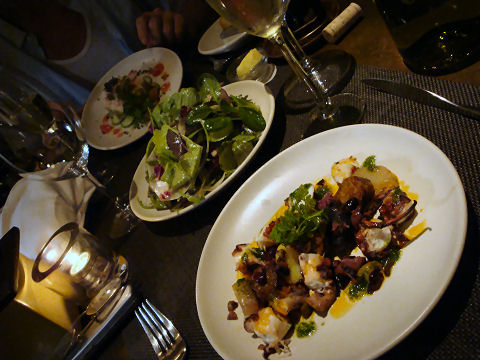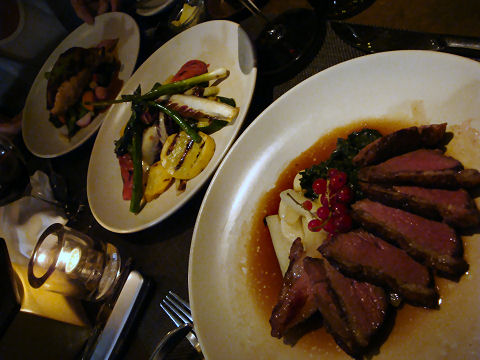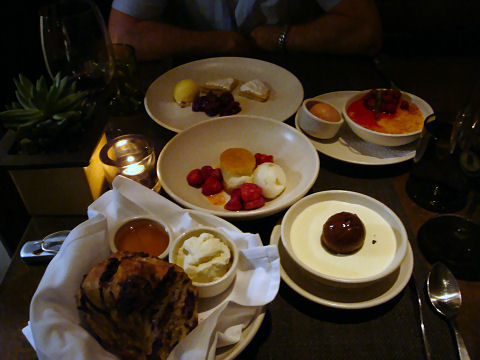“We’re starting with our own carbon footprint. Not nothing. But much of what we’re doing is already, or soon will be, little more than the standard way of doing business. We can do something that’s unique, different from just any other company. We can set an example, and we can reach our audiences. Our audience’s carbon footprint is 10,000 times bigger than ours. That’s the carbon footprint we want to conquer.”
– Rupert Murdoch
“Farm to table” or “pitchfork to fork” or “manure pile to menu” – I’m not sure what the currently PC term is for the whole locavore movement within restaurants, and, to be honest, I don’t care. Not that I don’t care about the environment, or reducing carbon footprints, or supporting local businesses… well, maybe the last I’m not as keen on, I’m a bit more globalist – why is the farmer down the road anymore deserving of support than the farmer in the middle of deepest, darkest wherever? We’re all sharing the planet together and in the long run, everything impacts everything else. Besides, I keep hearing that the globe is shrinking with all this modern technology, so isn’t the guy on the opposite side of the spinning ball really just as local as the guy you can shoot a spitball at?
I particularly don’t find it all that interesting in restaurants – oh, some things. Sure, it’s nice that the salad greens were just picked a couple of hours ago and are as fresh as can be. But if you make it your mission statement, your vision, your overarching concept, how do you justify your bar stocked with liquor brands from around the planet; your wine list with not only a specialization in wines from across the great pond, but not a single local wine gracing the listing; your decor of imported materials and decorated with plants native to another part of the world, the requirement that you empty a lovely cocktail from a glass into a plastic upon heading up to the rooftop a couple of people at a time in a power guzzling elevator? Those thoughts ran through my mind as I sat on the terrace of Print, 653 11th Avenue in the Ink 48 Hotel, sipping away at my Plymouth gin martini (gin from England, vermouth from France, olives, likely from California or Europe). But then, it was just a fleeting thought because the view from the rooftop is spectacular, particularly at sunset, with 360° of unobstructed New York City surrounding you, and who could sit there contemplating such things with all that? And besides, despite the writeups it’s gotten on the theme, the restaurant’s website really just notes that they incorporate local and sustainable ingredients, without making a big deal about it or claiming that it really is some deeply held vision.
Now, Print is run, at least partially, by people I know, which always gives me the pre-dinner jitters – the whole, “what do I write about if I don’t like the place?” motif. Really, I generally just don’t write about them if that’s the case. Or sometimes I do and take my chances. Thankfully, it’s not an issue here as we enjoyed ourselves immensely. There are some minor things I’m not fond of, not food-related other than the whole gimmick, which is what it is, of farm to table, but whatever floats your boat as they say, in particular the dining room – it’s small and noisy – there’s not a soft or sound-absorbing surface in the space and you can hear every conversation going on in there, from one end to the other, regardless of where you’re sitting. It’s not deafening, but it is a cacophony. And the plants – not because they’re from somewhere else but because they’re cacti, or at least succulents. I have nothing against the genre, but I don’t really want living spiky green things on my table – thankfully, they’re not particularly spiky, just the tips of their leaves, but they’re there, and taking up too much space on the table too. On to the food….



Overall, enjoyed. Service is attentive, friendly, and well-paced. The food, very good, and reasonably priced. It’s not the sort of place that will challenge you or make you sit up and take notice (other than that rooftop view), but it makes for a fine evening out – and as hotel restaurants go, pretty darned good.
Seems you’re eating pretty well.
Don’t forget to try the freshly toasted granola and fresh yogurt at Sarabeth’s (you ain’t, of course, but I always do) and maybe a dog from Gray’s!
Not a big hotdog fan, Gray’s or anyone else’s. And I’ll leave the hippie food to you… Granola and yogurt… Sheesh…
“[W]hy is the farmer down the road anymore deserving of support than the farmer in the middle of deepest, darkest wherever? We’re all sharing the planet together and in the long run, everything impacts everything else. Besides, I keep hearing that the globe is shrinking with all this modern technology, so isn’t the guy on the opposite side of the spinning ball really just as local as the guy you can shoot a spitball at?”
No Dan, he isn’t as local as the guy you can throw a spitball at. Nor is it that a farmer around the world is or is not deserving. What it really comes down to, and I’m surprised it puzzles you, is that local businesses help support the local (read your neighborhood/city/burg/whatever locale) economy. The farmer gets paid for his crops or animals, he spends at least a decent part of that money locally. This helps other local businesses, at least the ones the farmer buys from.
On the other hand, money sent across the world helps that farmer, certainly, and no doubt the local community there. Altruism aside, let those who live there also buy locally while we do the same and keep our money in our own local economy.
Another important reason to buy as locally as you can is that transportation costs and pollution are much less. If all it takes is a truck to drive my lettuce across town, that’s a lot less polluting that shipping or flying it across the globe or country.
If there were some way people could travel anywhere instantly so location and time didn’t matter, suppose everyone decided to go eat at restaurants in Europe or anywhere but Argentina. What would that do to Casa Saltshaker’s economy?
Ken, it doesn’t puzzle me in the slightest, I simply don’t agree with the reasoning. The transportation cost/pollution cost argument is not a given, it’s an assumption, and has been demonstrated by more than one study to be false when all factors are taken into account. The economic reasons only hold valid if you hold to a “supporting the local economy is better than supporting the global economy” viewpoint, which I don’t, and if your assumption that the person you pay locally is going to spend the bulk of his money locally – that may or may not be true. You also clearly have lost your sense of humor/sarcasm if you couldn’t see that in what I wrote.
As to restaurants in particular – I have no objection to someone sourcing their food locally, supporting local farmers, etc. I do find it a ridiculous conceit to make grand claims about how your restaurant is all about the locavore/locally sourced/sustainable movement, when the only thing you apply it to is your herbs, lettuces and maybe a few other ingredients. When it comes down to it, the vast bulk of what a restaurant buys is rarely sourced locally, even when much of it could be – from building materials to decorative items, to kitchen utensils, plates, glasses and flatware, linens, wines and liquors, bottled waters, soft drinks, spices, condiments, oils – the list could go on and on – and, if you want to get down to it, particularly in the NYC restaurant scene, probably at least some percentage of the staff are illegally in the country and working there. All things that ought to be considered part of such a grand vision/mission statement, but in my experience never are.
[…] meyer lemon & whipped lardo pappardelle), some quite good food, particularly the desserts, at Print, great sushi at Kanoyama, steak tartare at Locanda Verde, but mostly just good, casual eats, like a […]